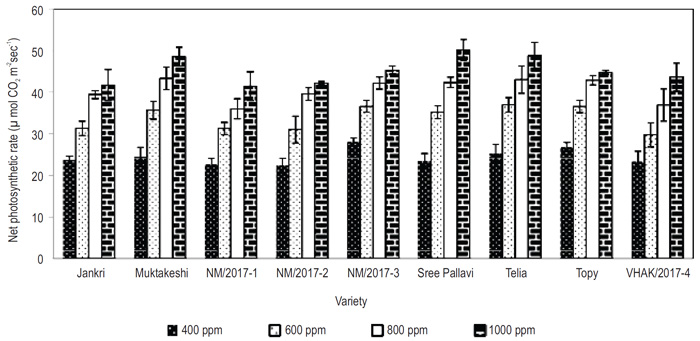| Tweet | Follow @co2science |
Paper Reviewed
Ravi, V., More, S.J., Nedunchezhiyan, M., Devi, A.A. and Nair, K.P. 2019. Potential increase in photosynthetic response of taro (Colocasia esculenta L.) to photon flux density and elevated CO2. Journal of Environmental Biology 40: 111-118.
Writing as background for their work, Ravi et al. (2019) note that taro (Colocasia esculenta), a perennial herbaceous crop, is "the fourteenth most important vegetable crop worldwide in terms of consumption," citing the work of Lebot and Aradhya (1991). What is more, they say that taro plants contain "more than twice the carbohydrate content of potatoes," and their leaves are "rich source[s] of carotene, potassium, calcium, phosphorus, iron, riboflavin, thiamine, niacin, vitamin A, vitamin C and dietary fibre."
Given the modern and projected future rise in atmospheric CO2 concentrations, Ravi et al. sought to identify the photosynthetic response of this key crop under ambient and elevated CO2 concentrations, noting that "understanding genotypic responses to elevated CO2 is "essential to identify genotypes with efficient CO2 capture potential" in a changing climate. And to accomplish this task, they grew nine taro genotypes (Sree Pallavi, Muktakesi, Jhankri, Telia, Topi, NM/2017-1, NM/2017-2, NM/2017-3 and VHAK/2017-4) at the ICAR-Central Tuber Crops Research Institute in Thiruvananthapuram, India. Then, during the fourth month after planting, the researchers measured the net photosynthetic rate of leaves under short-term exposure (10 min) to ambient (400 ppm) and elevated (600, 800 and 1000 ppm) atmospheric CO2 concentrations.
As revealed in the graphic below, elevated CO2 enhanced net photosynthesis in each of the nine taro genotypes, with increases ranging from 61 to 113 percent at 1000 ppm (relative to ambient CO2 at 400 ppm). The three genotypes with the highest photosynthetic responses to atmospheric CO2 enrichment were identified as Muktakeshi, Sree Pallavi and Telia. Consequently, the authors suggest more research should be conducted on these three promising varieties, which research is necessary to see if the responses observed here hold in a more natural growing season-long CO2-enrichment study.

Figure 1. Net photosynthetic response of nine Taro genotypes to atmospheric CO2 concentrations of 400, 600, 800 and 1000 ppm. Source: Ravi et al. (2019).
Reference
Lebot, V. and Aradhya, K.M. 1991. Isozyme variation in taro (Colocasia esculenta (L.) Schott) from Asia and Oceania. Euphytica 56: 55-66.




